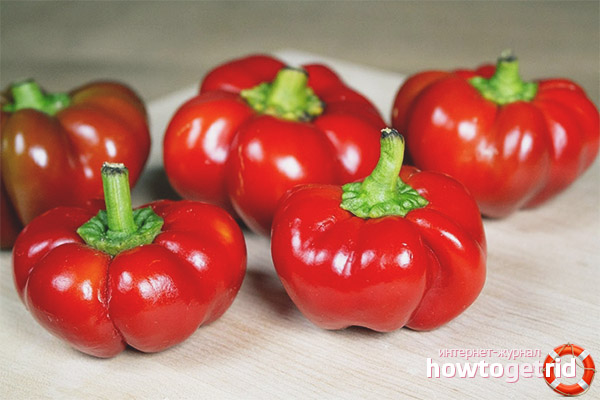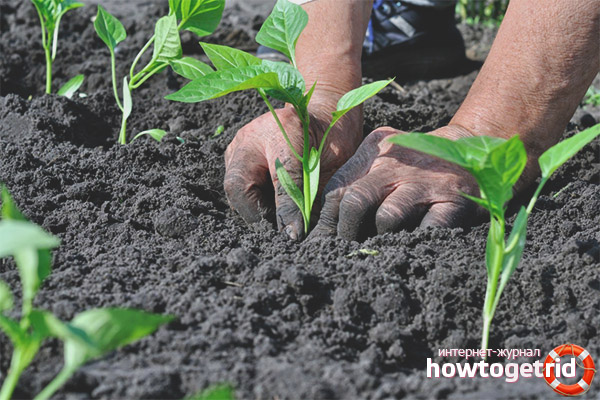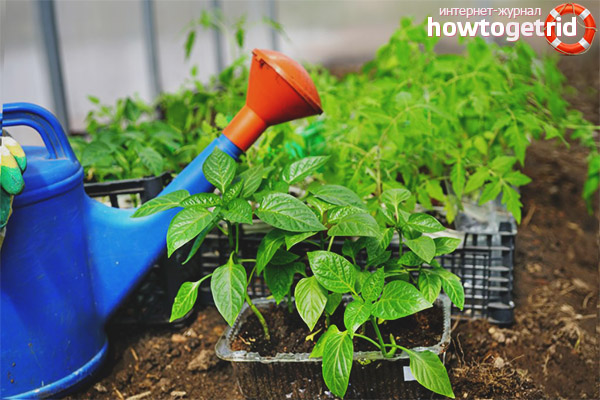The content of the article
Fruits are round in shape, bright red. The skin is smooth, the pulp is moderately dense. The variety is unpretentious. The variety is resistant to common diseases of the nightshade family. The fruit contains a complex of nutrients. The plant has a high yield. The composition of the fruit contains a large amount of dry matter.
Variety description Kolobok
The plant is strong, low. In the seed chambers, a small number of seeds ripen. Fruits are used for harvesting for the winter, eat fresh. Due to the high yield of pepper, breakage of the bush under the weight of the fruits can occur. You can plant seedlings in the ground after four weeks from the moment of its planting.
Growing seedlings
Seedlings are planted at the age of 30-50 days in open ground or greenhouses after May 20, when the threat of frost passes. Perlite can be added to the soil, which improves soil friability.
Seedlings can be grown independently in boxes on the windowsill. Boxes are filled with fertile soil, taking into account the possible subsidence of the earth.
- Seeds are sown 50-55 days before the planned planting in the ground or greenhouse. When condensation occurs, the seedlings are aired. Sprouts of gingerbread pepper will appear in about 7 days. Sprouts of pepper are kept in a warm, well-lit place.
- The light mode is one of the important indicators when growing seedlings of bell pepper. With a lack of lighting, the seedlings become weak, elongated. Such plants do not tolerate transplantation, subsequently they give a poor harvest. Restore such plants will not help fertilizing with complex fertilizers, timely watering.
- In the morning and evening for 2 hours, it is recommended to illuminate the seedlings with fluorescent lamps. Seedlings at the age of 20 days need fertilizing with nitrogen fertilizers. Watering young plants is carried out with warm water. Pepper does not like drafts and bright direct rays of the sun, which can cause burns of young foliage.
- Seedlings of Bulgarian pepper Kolobok feel comfortable in porous and permeable soil.
- Young plants are covered with a film to create a greenhouse effect. Sprouts of pepper need to be watered very carefully, and after a month the film begins to be periodically opened slightly for hardening seedlings.
- From time to time you need to loosen the earth. Due to this, the root system will be able to receive air and moisture.
- When 4 true leaves appear, peppers are carefully dived into separate pots or plastic cups. This enables the root system to form better. The soil should be loose, fertile and structured.
When growing pepper seedlings on a windowsill, place it in steps. The stepwise arrangement of plants at the window will enable all instances to obtain the necessary portion of sunlight. Closest to the window, put low plants, then those above.
Open transplant
On one square meter, 4-5 bushes of Kolobok pepper can be placed. Planting seedlings is best done in cloudy weather. Humus, peat or compost are added to the wells, watered abundantly with water.
- Plants from pots get out with a lump of earth, without injuring the roots. The root system of bell pepper is restored for a long time after transplantation, therefore it is important to injure it as little as possible. Planting holes can be pre-charged with superphosphate.
- Experienced gardeners recommend picking buds or flowers on seedlings.The fact is that in a pot or glass, due to its small area and poor nutrition, the plant throws all its forces into blooming and forming a crop. After the transplant, when there is enough space for the plant, the seedlings begin to grow roots and for some time the growth of the aerial part stops.
- Do not rush to feed the seedlings with fertilizers, the first feeding can be done 12 days after planting the plants in open ground. Subsequent feeding is done every 14 days with watering.
- Pepper is a heat-loving plant, do not rush to plant seedlings in the ground until the threat of night-time frost return passes. When the temperature drops to 10-12 degrees, growth stops, the root system weakens, ceases to fulfill its function in full, the plant itself becomes lethargic and pale.
- The distance between the planting pits is allowed 30 cm, between the rows - 70 cm. Immediately after planting, seedlings can be shaded with non-woven covering material. In two months, oxidative processes take place in pepper plants, and organic substances are synthesized. During this period, plants are particularly demanding on irrigation and mineral fertilizers.
For digging in the fall, it is advisable to bring humus, it must be combined with the upper fertile soil layer.
Bush formation
To increase the yield and improve the quality of the fruit, it is recommended to form a bush of pepper. Lower leaves should be removed. It is also recommended to get rid of numerous stepsons and overly developing side shoots.
To get enough light and air for the bush, remove excess leaves. When reaching a bush height of 60 cm, pinch the top, thereby provoking the formation of flowers and ovaries on the side shoots.
Watering and mulching
Do not pour pepper on top of the leaf. It is best to water the bushes under the root, in the holes or grooves. If possible, drip irrigation can be established. Lack of moisture in the soil depresses the root system.
Mulching the soil near the plants and in the aisles is very beneficial for the condition of the bushes. Use hay, sawdust or compost as mulch. As practice shows, the bushes under the mulch bear fruit well, give a plentiful harvest before the onset of frost.
After watering, weed growth is activated. Do not forget to systematically destroy weeds and loosen the soil. Mulching helps to get rid of frequent loosening.
Secrets of a plentiful harvest
Do not plant pepper seedlings before the 20th of May, a sharp cooling and rainy weather will inevitably lead to a deterioration of heat-loving seedlings.
- Properly grown seedlings form a powerful root system. Dive seedlings into separate containers to grow additional roots.
- Pepper Kolobok is grown only in seedlings. To accelerate the emergence of seedlings, use double-coated greenhouses. It allows you to keep the heat accumulated during the day longer.
- Use herbal infusion for top dressing. To prepare it, garden tops and nettles are poured with warm water and left to roam for 3 weeks. After fermentation, the solution is filtered, diluted with water and watered with pepper plants.
- In the hot summer months, shade the bushes and often water them strictly under the root or in the grooves.
- Following these recommendations, it will be possible to get an excellent harvest of the original gingerbread round peppers. Using agrofibre as a protection, gardeners will be able to protect themselves from return frosts.
To prevent the appearance of apical decay, use potash fertilizers during the flowering and ripening of fruits.
Video: how to plant and grow peppers












Submit